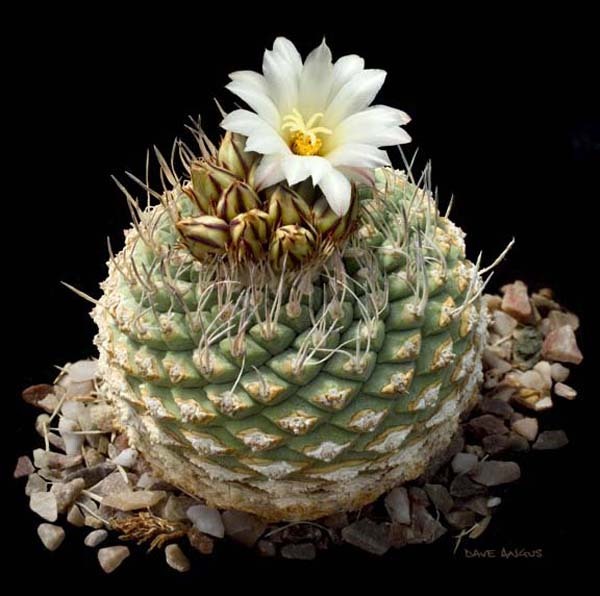
Growth Habits: Generally solitary, globose, the body of the plant is naturally a greyish green, but I have seen a number of different shades of green. The stems can be up to around 5 inches tall (12 cm), and 4 inches in diameter (10 cm); The younger areoles have a silky wool and 1 to 4 silky grey spines, approx. ½ in, in diameter (1.5 cm), older areoles tend to lose their spines over a period of time. There are several different sub species which usually have different coloured flowers.
Scientific name: Strombocactus Disciformis
Common names: Fir Cone Cactus, Spinning Top Cactus.
Synonym: Echinocactus disciformis, Ariocarpus disciformis ssp. jarmilae, Echinocactus turbiniformis, Pediocactus jarmilae, Strombocactus disciformis ssp. jarmilae, Pediocactus jarmilae, Cactus disciformis, Strombocactus jarmilae, Ariocarpus disciformis, Mammillaria disconfirms.
Etymology: The generic name "Strombocactus” derives from the Greek word strombos meaning ""fir cone, spinning top” referring to the shape of the plants, and the word cactus (an old genus name). Disciformis: From the Latin adjective disciformis which means “disk-shaped, circular, flat,”. ( The specific name implies: "disk shaped")
Origin: Mexico (Queretaro, Hidalgo)
Light: Full sun to part shade will keep this one happy
Compost: I know that we say it about most cacti, but this one really must have good drainage. The root system will not stand being constantly wet.
Water: Water sparingly during the summer months and keep dry in winter, particularly if the air is humid.
Flower: The flowers are white with pinkish tips and yellow centres. The stamens are also yellow
Fruit: The fruits are relative small and the seeds are extremely tiny.
Min. temp: 50°f. (approx. 10°c) is a reasonably safe winter temperature if the plant is kept dry.
Cultivation: Not the easiest plant to keep looking healthy and unmarked. As the plant ages it tends to get the characteristic ’corky’ marks reminiscent of so many cacti. These marks are are part of the normal growing pattern of the plant, but do sometimes spoil the plants appearance. Usually grown from seed as vegetative propagation is virtually impossible, unless you have a laboratory. The first couple of years are the most difficult when the plant seems to be at its most vulnerable. But great care must always be taken with this species.
Habitat: The plants grow on very steep or even vertical surfaces consisting of soft crumbly slate and the population density is sometimes high, several dozen plants varying from seedlings to adults plants can be found in a single square yard.
Comments: This is a beautiful plant and much sought after. For those people who are impatient (and I'm sure we all suffer from that to some degree) this plant is very slow growing, in fact some years it does not seem to put on any growth at all. It comes into the bracket of plants that non-cacti aficionado's sometimes say when they look at them "is it alive." To which your reply should be "it is probably more alive than you are . . ." There are many collectors who seek all of the sub species so that they have got ‘the set’ so to speak.
Photograph by kind permission of David Angus http://www.botanica.uk.net/cacti.htm










